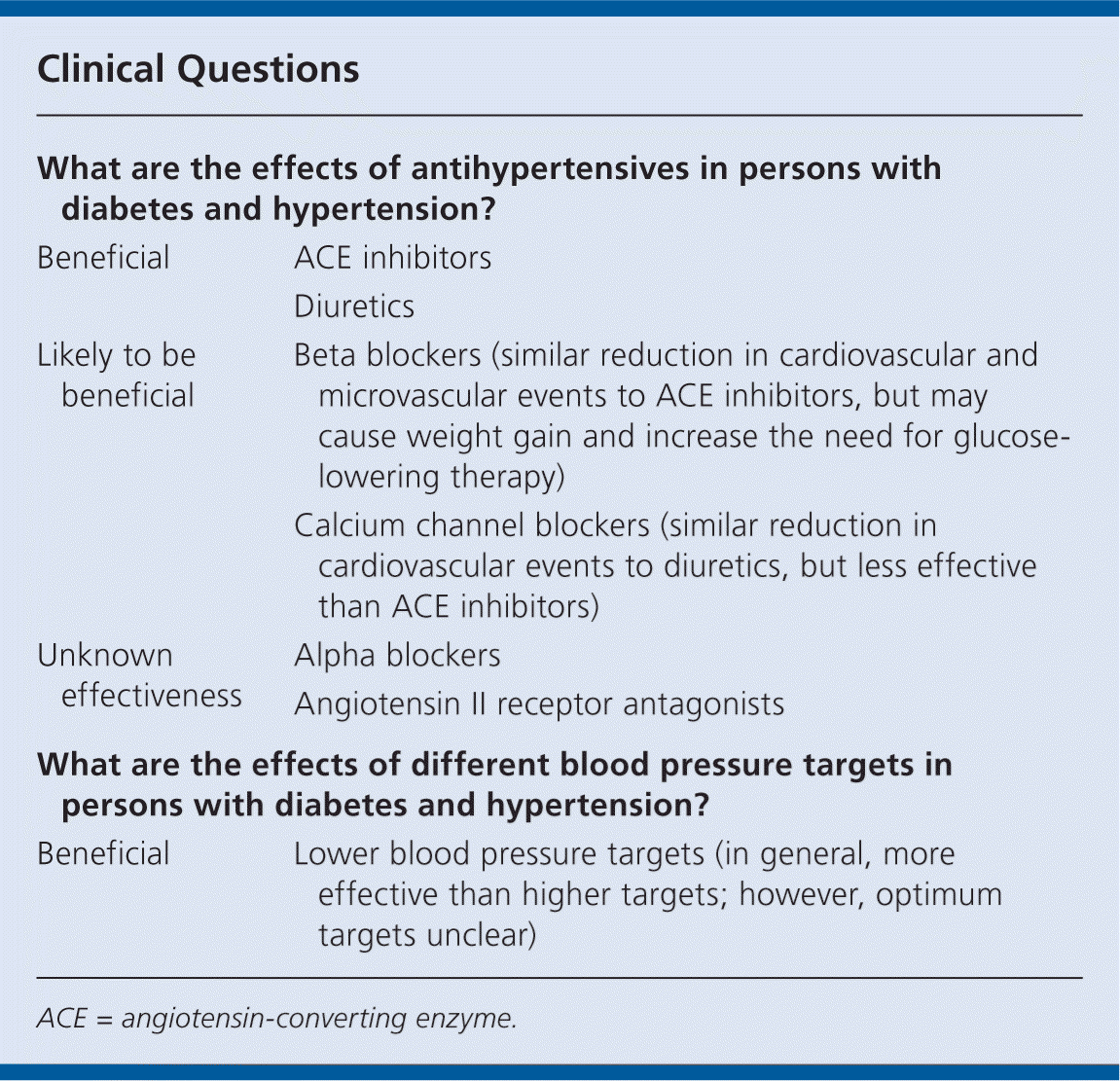
Am Fam Physician. 2013;87(8):574-575
Author disclosure: Sandeep Vijan is the coauthor of one systematic review referenced in this review.
Among persons with diabetes, about 40 percent of those aged 45 years, and more than 60 percent of those 75 years and older, will have a blood pressure greater than 140/90 mm Hg.
Major cardiac events occur in approximately 5 percent of persons with diabetes and untreated hypertension each year, and the risk is higher in those with other risk factors, such as diabetic nephropathy.
We cannot be sure how different treatments compare in persons with diabetes and hypertension. However, evidence suggests that either angiotensin-converting enzyme (ACE) inhibitors or diuretics are effective first-line treatments.
ACE inhibitors reduce the risk of renal disease compared with placebo, and they seem to reduce cardiovascular events compared with calcium channel blockers. However, they can cause cough and angioedema.
Diuretics, such as chlortalidone, reduce cardiovascular events compared with placebo, but they may increase glucose, cholesterol, and uric acid levels.
Diuretics seem as effective as ACE inhibitors at preventing cardiovascular events, and they may be more effective than calcium channel blockers at reducing the risk of heart failure.
Beta blockers may be as effective as ACE inhibitors at reducing onset of renal disease and other diabetes-related cardiovascular and microvascular events, or diabetes-related death. However, they may cause weight gain and increase the need for glucose-lowering treatment.
Calcium channel blockers seem as effective as diuretics, more effective than beta blockers, and less effective than ACE inhibitors at reducing cardiovascular events overall, and amlodipine may be less effective at preventing heart failure compared with chlortalidone.
We found conflicting evidence on long-term outcomes with angiotensin II receptor antagonists.
We do not know whether alpha blockers reduce cardiovascular events in persons with diabetes and hypertension.
It seems likely that more intensive treatment to achieve a greater reduction in blood pressure leads to a greater reduction in cardiovascular events and overall mortality. However, it is difficult to specify a target blood pressure in persons who have diabetes and hypertension.

| What are the effects of antihypertensives in persons with diabetes and hypertension? | |
| Beneficial | ACE inhibitors |
| Diuretics | |
| Likely to be beneficial | Beta blockers (similar reduction in cardiovascular and microvascular events to ACE inhibitors, but may cause weight gain and increase the need for glucose-lowering therapy) |
| Calcium channel blockers (similar reduction in cardiovascular events to diuretics, but less effective than ACE inhibitors) | |
| Unknown effectiveness | Alpha blockers |
| Angiotensin II receptor antagonists | |
| What are the effects of different blood pressure targets in persons with diabetes and hypertension? | |
| Beneficial | Lower blood pressure targets (in general, more effective than higher targets; however, optimum targets unclear) |
Definition
Hypertension in diabetes is classically defined as a systolic blood pressure of 140 mm Hg or greater, or a diastolic blood pressure of 90 mm Hg or greater.
Hypertension is divided into three stages. Prehypertension is a systolic blood pressure of 120 to 139 mm Hg, or a diastolic blood pressure of 80 to 89 mm Hg. Stage 1 hypertension is a systolic blood pressure of 140 to 159 mm Hg, or a diastolic blood pressure of 90 to 99 mm Hg. Stage 2 hypertension is a systolic blood pressure of 160 mm Hg or greater, or a diastolic blood pressure of 100 mm Hg or greater. However, guidelines now suggest that drug therapy should be instituted in any person with diabetes and hypertension, regardless of the stage of the disease.
This review focuses on adults with diabetes and stage 1 or stage 2 hypertension, but with no diagnosis of coronary heart disease, diabetic retinopathy, or nephropathy. Most studies on the subject do not differentiate between type 1 and type 2 diabetes, but the underlying epidemiology and ages of the populations studied suggest that more than 95 percent of study participants are likely to have type 2 diabetes.
Incidence and Prevalence
Hypertension is highly prevalent among persons with diabetes. It is about 1.5 to 3 times more common in persons with type 2 diabetes than in the age-matched general population. Using a diagnostic threshold of 140/90 mm Hg, about 40 percent of persons with diabetes have hypertension at 45 years of age, and more than 60 percent have hypertension by 75 years of age. About 30 percent of individuals with type 1 diabetes eventually develop hypertension, usually after they develop diabetic nephropathy. The prevalence of hypertension varies depending on the population studied.
Etiology and Risk Factors
The cause of hypertension is multifactorial, complex, and not fully understood. In the general population, there are several major risk factors for hypertension; specific risk factors are not clearly different in persons who have diabetes. Age is the predominant factor; data suggest that prevalence increases with age. Individuals with at least one parent with hypertension are about twice as likely to develop hypertension. In the United States, blacks have a 7 to 10 percent increase in prevalence compared with non-Hispanic whites. Persons who are obese also have greater risk: for each unit increase in body mass index, the prevalence increases by about 1 to 1.5 percent. Insulin resistance is associated with the development of hypertension.
Prognosis
Untreated hypertension in persons with diabetes is associated with high rates of cardiovascular disease (such as myocardial infarction, heart failure, and stroke) and microvascular disease (such as renal disease [including albuminuria, renal insufficiency, and end-stage renal disease] and diabetic retinopathy). In the placebo groups of major trials of hypertension control in type 2 diabetes, major cardiac events occurred in about 4 to 6 percent of persons annually, and were substantially higher in populations with additional risk factors, such as diabetic nephropathy.
EDITOR'S NOTE: Chlortalidone is called chlorthalidone in the United States.
SEARCH DATE: April 2011.
Adapted with permission from Vijan S. Diabetes: treating hypertension. Clin Evid Handbook.
